Look up and see Saturn as it changes directions in the sky tonight
Saturn will reverse its direction overnight and begin its westward path across the sky.

Saturn will reverse its direction today (June 17) and begin its westward path across the sky.
Starting today, Saturn enters retrograde, shifting from its usual eastward movement to begin traveling westwards through the constellations instead. The ringed planet will enter retrograde motion at 12:51 p.m. EDT (1651 GMT) and will be visible in the constellation Aquarius later in the evening, appearing in the east just after midnight in the early hours of Sunday (June 18). Saturn will continue on this path of retrograde until early November.
This change in direction is a phenomenon known as retrograde motion and is caused by the Earth's motion around the sun, such that as the Earth orbits the sun, our perspective on Earth changes, causing the apparent position of objects like the planets in our solar system to move from side to side throughout the year, according to the skywatching website In-The-Sky.org.
Related: Night sky, June 2023: What you can see tonight [maps]

Want to get a good look at Saturn or other planets in the night sky? We recommend the Celestron Astro Fi 102 as the top pick in our best beginner's telescope guide.
All of the solar system's outer planets periodically undergo this type of "backward" movement a few months before they reach opposition, or opposite side of the sky from the sun with Earth in between.
Saturn's retrograde coincides with the start of the planet's apparition, or period of peak visibility in the night sky. Apparitions of the outermost solar system planets like Saturn occur once a year and last roughly 6-9 months, according to In-The-Sky.org.
Although Saturn has been visible in the pre-dawn sky for a few weeks now, it will start to be visible in the evening sky, as the planet approaches opposition on August 27. Saturn will reach its position directly opposite Earth at 4:20 a.m. EDT (0820 GMT). At this phase, it will be visible for much of the night, reaching its highest point in the sky around midnight local time.
Breaking space news, the latest updates on rocket launches, skywatching events and more!
If you're hoping to observe Saturn, our guides for the best telescopes and best binoculars are a great place to start. If you're looking to snap photos of the night sky, check out our guide on how to photograph the moon, as well as our best cameras for astrophotography and best lenses for astrophotography.
Editor's Note: If you snap a photo of Saturn, and would like to share it with Space.com's readers, send your photo(s), comments, and your name and location to spacephotos@space.com.

Samantha Mathewson joined Space.com as an intern in the summer of 2016. She received a B.A. in Journalism and Environmental Science at the University of New Haven, in Connecticut. Previously, her work has been published in Nature World News. When not writing or reading about science, Samantha enjoys traveling to new places and taking photos! You can follow her on Twitter @Sam_Ashley13.
